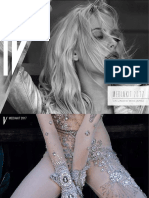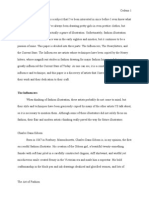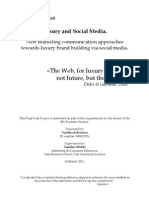French Fashion
French Fashion
Uploaded by
Garima ThakurCopyright:
Available Formats
French Fashion
French Fashion
Uploaded by
Garima ThakurOriginal Title
Copyright
Available Formats
Share this document
Read this document in other languages
Did you find this document useful?
Is this content inappropriate?
Copyright:
Available Formats
French Fashion
French Fashion
Uploaded by
Garima ThakurCopyright:
Available Formats
FRENCH FASHION
SUBMITTED BY:Garima Thakur Section E A1802011158
INTRODUCTION:Fashion has been an important industry and cultural export of France since the seventeenth century, and modern "haute couture" originated in Paris in the 1860s. Today, Paris, along with London, Milan, and New York City, is considered one of the world's fashion capitals, and the city is home or headquarters to many of the premier fashion houses, including Balenciaga, Cline, Chanel, Chloe, Dior, Givenchy, Jea n-Paul Gaultier, Herms, Lanvin,Rochas, Vuitton and Yves Saint Laurent. The association of France with fashion and style (French: la mode) dates largely to the reign of Louis XIV when the luxury goods industries in France came increasingly under royal control and the French royal court became, arguably, the arbiter of taste and style in Europe. The rise in prominence of French fashion was linked to the creation of the fashion press in the early 1670s (due in large part to Jean Donneau de Vis) which transformed the fashion industry by marketing designs to a broad public outside the French court and by popularizing notions such as the fashion "season" and changing styles. Louis XIV notably introduced one of the most noticeable feature of the men's costume of the time : the immense wigs of curled hair.It is said these originated from the fact that Louis XIV started to wear wigs as he was getting bald, and to imitate this his courtiers put
on false hair The wearing of wigs lasted for over a century; they went through many changes, but they were never quite so exaggerated as during this period. The extravagant, luxurious and evanescent styles of the French Royal court led the courtiers to run up enormous debts to keep up the pace, at the peasants expense. Such fashion sprees notably ruined Marie Antoinettes reputation, and were one of the many factors paving the way for the French Revolution. The Sans-culottes (lit. Without knee-breeches) rejected the powdered wigs and the knee-breeches assimilated to the nobility and favored informal styles (full-length trousers, and natural hairs...), which finally triumphed over the brocades, lace, periwig, and powder of the earlier eighteenth century.
World War II
Many fashion houses closed during occupation of Paris during World War II, including the Maison Vionnet and the Maison Chanel. In contrast to the stylish, liberated Parisienne, the Vichy regimepromoted the model of the wife and mother, the robust, athletic young woman, a figure who was much more in line with the new political criteria. Germany, meanwhile, was taking
possession of over half of what France produced, including high fashion, and was also considering relocating French haute couture to the cities of Berlin and Vienna, neither of which had any significant tradition of fashion. The archives of the Chambre Syndicale de la Couture were seized, most consequentially the client list. Jews were excluded from the fashion industry. Due to the difficult times, the number of models in shows was limited to seventy-five, evening wear was shortened and day wear was much lighter, made using substitute materials whenever possible. From 1940 onward, no more than thirteen feet (four meters) of cloth was permitted to be used for a coat and a little over three feet (one meter) was all that allowed for a blouse. No belt could be over one and a half inches (four centimeters) wide. Among young men in the War Years the zazou suit became popular. In spite of the fact that so many fashion houses closed down or moved away during the war, several new houses remained open, including Jacques Fath, Maggy Rouff, Marcel Rochas, Jeanne Lafaurie,Nina Ricci, and Madeleine Vramant. During the Occupation, the only true way for a woman to flaunt her extravagance and add to colour to a drab outfit was to wear a hat. In this period, hats were often made of scraps of material that would have otherwise been thrown away, sometimes
incorporating butter muslin, bits of paper, and wood shavings. Among the most innovative millionars of the time were Pauline Adam, Simone Naudet, Rose Valois, and Le Monnier
Post-War
Post-war fashion returned to prominence through Christian Dior's famous "New Look" in 1947: the collection contained dresses with tiny waists, majestic busts, and full skirts swelling out beneath small bodices, in a manner very similar to the style of the Belle poque. The extravagant use of fabric and the feminine elegance of the designs appealed greatly to a post-war clientele. Other important houses of the period included Pierre Balmain and Hubert de Givenchy (opened in 1952). The fashion magazine Elle was founded in 1945. In 1952, Coco Chanel herself returned to Paris. In the 1960s, "high fashion" came under criticism from France's youth culture (including the y-ys) who were turning increasingly to London and to casual styles. In 1966, the designer Yves Saint Laurent broke with established high fashion norms by launching a prt--porter ("ready to wear") line and expanding French fashion into mass manufacturing and marketing (member houses of the Chambre Syndicale were forbidden to use even sewing
machines).Further innovations were carried out by Paco Rabanne and Pierre Cardin. In post-1968 France, youth culture would continue to gravitate away from the "sociopolitically suspect" luxury clothing industry, preferring instead a more "hippy" look (termed baba cool in French).With a greater focus on marketing and manufacturing, new trends were established by Sonia Rykiel, Thierry Mugler, Claude Montana, Jean-Paul Gaultier and Christian Lacroix in the 1970s and 80s. The 1990s saw a conglomeration of many French couture houses under luxury giants and multinationals such as LVMH. Since the 1960s, France's fashion industry has come under increasing competition from London, New York, Milan and Tokyo. Nevertheless, many foreign designers still seek to make their careers in France: Karl Lagerfeld (German) at Chanel, John Galliano (British) at Dior, Paulo Melim Andersson (Swedish) at Chloe, Stefano Pilati (Italian) at Yves Saint Laurent, Marc Jacobs (American) at Louis Vuitton, Kenzo Takada (Japanese) and Alexander McQueen (English) at Givenchy (until 2001)
WHY IS PARIS THE CAPITAL OF FASHION?
Why is Paris the capital of fashion? There are a number of reasons, mostly dating back to the 18th century, although it can be argued that Paris' fashion hegemony started well before that. While it lost ground during World War II, it came back with a vengeance and has remained the mainstay of fashionistas since.
Haute Couture began in the 18th century, but the French had been looked to with admiration or disdain in their dress sense well before that. In the 16th century, Anne Boleyn was famous for wearing a French-style hood, which showed her hair and had a generally provocative style. Even then, the French were famous for their liberal attitude towards sexuality. In the 18th century, couturier Rose Bertin was named the Minister for Fashion and the position was still retained in the Napoleonic era. Initially, it was the rich and powerful telling the designers what they wanted to wear in clothes, but in the 19th century, this changed. It was, surprisingly, an Englishman working in Paris who became the father of modern Haute Couture when Charles Worth
put his name on his clothing labels. He went a step further, creating designs based on his own ideas and displaying them on live models so that clients could approve or disapprove. The novelty was a success and designers then began to dictate what was fashionable. From then on, it was understood that any designer who wanted to be a success had to be in Paris and become part of a couture house or form their own. Paris was the home of fashion shows and all the fashion magazines were either based in or looked to Paris for their information. For women throughout the Western world, Paris was the be all and end all of clothes.
The Power of Paris London, New York and Milan can all lay claim to some fashion influence. Especially during World War II, New York and London made inroads while Paris was occupied by Germany. But when the war was over, designers returned to Paris and couture reigned again. Chanel was still popular, but Dior became one of
the most influential designers of the mid-century. Joined by Yves Saint Laurent and other prominent designers, Paris cemented its hold on style. But why is Paris the capital of fashion today? Simply because little has changed, despite the drop in the number of couture houses. The most important fashion shows still take place in Paris and more aspiring designers go to the city to learn and showcase their work than they do London, New York or Milan. The Golden Triangle To better understand why Paris is the capital of fashion, you need to consider the golden triangle - a shopping district in Paris dedicated exclusively to high fashion clothes and accessories. The triangle lives between the Avenue Marceau, the ChampsElysees and the Avenue Montaigne. In it, you will find the homes of Vuitton, Givenchy, Rochas, Dior, Celine, Chanel, Donna Karan and Hermes, just to start you off.
Paris' Ongoing Allure Although there are certainly those who try to claim otherwise, Paris is still the fashion capital of the world. While it is true that the fashion magazines and designers don't have the absolute power they once did, the ability to be flexible and understand changing tastes and trends is what keeps Paris a magnet for the fashion world. The idea of a "Paris Original" may not thrill women the way it once did, but people certainly still respond to interesting, inventive and wearable clothes - and item for item, the bulk of those still come from Paris.
Paris Fashion Week The annual Fashion Week is a six-week dash which sends buyers around the globe to capture all the catwalk styles and make sure they stock up on the new trends for the Autumn/Winter season of the following year.
Paris is the last stop after a week each in New York, London and Milan, with just one day's break between each show. Paris Fashion Week usually takes place during the last few days of February into the first week of March. Most of the catwalk displays are held at the Carrousel du Louvre, below the Louvre Museum with hourly shows from 10:00 to 19:00. Shows also take place at several other venues throughout the city. There are also Catwalk Calendar Off events for the newer/alternative designers. Admittance is strictly reserved for fashion professionals only. During this annual event the designer's Women's Ready to Wear Fall/Winter collections are shown. The new trends, colours and must-haves are reported on avidly in the press, on French television, and subsequently by the world's press.
Paris' restaurants, hotels and watering-holes are filled with the world's models, photographers, journalists and fashion editors. It is very difficult to find accommodation in Paris during Fashion Week. Although the event is closed to members of the public, the excitement of the event definitely adds to the glamour of living in Paris Open to the public Weekly fashion shows, which are open to the public, are held in the large department stores along Boulevard Haussman. For reservation details contact Printemps department store and Galeries Lafayette. You can avoid all the bustle of the fashion shows and go straight to the source, by just going shopping, in
the boutiques and department stores all over Paris. Most of the world's designers have a presence in Paris.
You might also like
- Museum Quality The Rise of The Fashion Exhibition0% (1)Museum Quality The Rise of The Fashion Exhibition26 pages
- 42 The Three Investigators and The Mystery of Wrecker's Rock100% (1)42 The Three Investigators and The Mystery of Wrecker's Rock107 pages
- Mushoku Tensei Volume 22 - Cliff ChapterNo ratings yetMushoku Tensei Volume 22 - Cliff Chapter387 pages
- France: The Destination of Fashion: Baiq Desyta S. Hartika Arbiyanti Lana Syahbani Putri Elok S. Yulinar Amalia0% (1)France: The Destination of Fashion: Baiq Desyta S. Hartika Arbiyanti Lana Syahbani Putri Elok S. Yulinar Amalia37 pages
- Prospectus Academic Programmes Fashion DesignNo ratings yetProspectus Academic Programmes Fashion Design69 pages
- "Glamour: Fashion, Industrial Design, Architecture" at San Francisco MOMANo ratings yet"Glamour: Fashion, Industrial Design, Architecture" at San Francisco MOMA1 page
- Role of Our Culture in The Fashion IndustryNo ratings yetRole of Our Culture in The Fashion Industry8 pages
- Genderless Streetwear Fashioning PresentNo ratings yetGenderless Streetwear Fashioning Present87 pages
- Vintage Fashion - Collecting and Wearing Designer Classics - Baxter-Wright, Emma, Photographer - 2009 - New York - Collins Design - 9780062120861 - Anna's ArchiveNo ratings yetVintage Fashion - Collecting and Wearing Designer Classics - Baxter-Wright, Emma, Photographer - 2009 - New York - Collins Design - 9780062120861 - Anna's Archive228 pages
- The Impact and Significance of Fashion Trends On Culture and The Influence of Fashion On Our Everyday Lives.No ratings yetThe Impact and Significance of Fashion Trends On Culture and The Influence of Fashion On Our Everyday Lives.3 pages
- The Rise of Vintage Fashion and The Vintage Consumer: November 2012No ratings yetThe Rise of Vintage Fashion and The Vintage Consumer: November 201225 pages
- 10 Most Famous Fashion Designers of All Time100% (2)10 Most Famous Fashion Designers of All Time6 pages
- Auner Garcia - Wedding Traditions Around The WorldNo ratings yetAuner Garcia - Wedding Traditions Around The World4 pages
- Full Principles of Highway Engineering and Traffic Analysis 5th Edition Ebook All ChaptersNo ratings yetFull Principles of Highway Engineering and Traffic Analysis 5th Edition Ebook All Chapters34 pages
- The Oresteia: Agamemnon The Libation Bearers The Eumenides100% (1)The Oresteia: Agamemnon The Libation Bearers The Eumenides71 pages
- O O O O O O: Practice Test 7 MULTIPLE CHOICE: (8 Points)No ratings yetO O O O O O: Practice Test 7 MULTIPLE CHOICE: (8 Points)5 pages
- DGFT Public Notice No.27/2015-2020 Dated 14th July, 2015No ratings yetDGFT Public Notice No.27/2015-2020 Dated 14th July, 201511 pages
- What I Know: NAME: - Quiz #5 - Thursday SECTION100% (1)What I Know: NAME: - Quiz #5 - Thursday SECTION15 pages
- European fashion: The creation of a global industryFrom EverandEuropean fashion: The creation of a global industry
- 42 The Three Investigators and The Mystery of Wrecker's Rock42 The Three Investigators and The Mystery of Wrecker's Rock
- France: The Destination of Fashion: Baiq Desyta S. Hartika Arbiyanti Lana Syahbani Putri Elok S. Yulinar AmaliaFrance: The Destination of Fashion: Baiq Desyta S. Hartika Arbiyanti Lana Syahbani Putri Elok S. Yulinar Amalia
- "Glamour: Fashion, Industrial Design, Architecture" at San Francisco MOMA"Glamour: Fashion, Industrial Design, Architecture" at San Francisco MOMA
- Vintage Fashion - Collecting and Wearing Designer Classics - Baxter-Wright, Emma, Photographer - 2009 - New York - Collins Design - 9780062120861 - Anna's ArchiveVintage Fashion - Collecting and Wearing Designer Classics - Baxter-Wright, Emma, Photographer - 2009 - New York - Collins Design - 9780062120861 - Anna's Archive
- The Impact and Significance of Fashion Trends On Culture and The Influence of Fashion On Our Everyday Lives.The Impact and Significance of Fashion Trends On Culture and The Influence of Fashion On Our Everyday Lives.
- The Rise of Vintage Fashion and The Vintage Consumer: November 2012The Rise of Vintage Fashion and The Vintage Consumer: November 2012
- Auner Garcia - Wedding Traditions Around The WorldAuner Garcia - Wedding Traditions Around The World
- Full Principles of Highway Engineering and Traffic Analysis 5th Edition Ebook All ChaptersFull Principles of Highway Engineering and Traffic Analysis 5th Edition Ebook All Chapters
- The Oresteia: Agamemnon The Libation Bearers The EumenidesThe Oresteia: Agamemnon The Libation Bearers The Eumenides
- O O O O O O: Practice Test 7 MULTIPLE CHOICE: (8 Points)O O O O O O: Practice Test 7 MULTIPLE CHOICE: (8 Points)
- DGFT Public Notice No.27/2015-2020 Dated 14th July, 2015DGFT Public Notice No.27/2015-2020 Dated 14th July, 2015
























































































